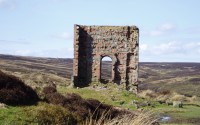Before, during and after industry: The North York Moors ‘This Exploited Land’ project
- Date
- 14 Feb 2017
- Start time
- 7:30 PM
- Venue
- Tempest Anderson Hall
- Speaker
- Dr Louise Cooke

Before, during and after industry: The North York Moors ‘This Exploited Land’ project
by Dr Louise Cooke, formerly of North York Moors National Park
Joint lecture with PLACE & the Royal Geographical Society
The North York Moors saw an explosion of industry through the 19th Century, focusing on the exploitation of rich Ironstone deposits in the Esk Valley and Rosedale. The landscape today and the exploitation of its mineral wealth is interwoven and this challenges the perception of the landscape of the North York Moors today as something ‘natural’.
This lecture presents a ‘before, during and after’ narrative to contextualise the physical remains and extend understanding from industrial archaeological ‘sites’ to a broader, heritage landscape focus. Alongside the stories of how the landscape has been used, the lecture will also consider the stories of the people who lived and worked in the landscape in the past and those who value and use the landscape today.
The ironstone landscapes are now a focus for a 4 year HLF Landscape Partnership Scheme – This Exploited Land – which aims to understand, protect and enhance the landscape and its legacy of ironstone exploitation in the North York Moors.
Member’s report
Heritage Lottery funding was secured in 2016 for this project to examine how the quiet agricultural landscape of the Esk Valley and Rosedale was affected by ironstone mining in the 19th century. Rich deposits were first extracted in the 1830s, prompting the building of early railways lines to the sea. Mining flourished on an industrial scale from the 1860s, with 38% of Britain’s need for iron, and about 20% of world demand, satisfied from these parts, until cheaper availability of ironstone elsewhere saw terminal decline by the 1920s. Successful exploitation saw Grosmont expand rapidly from a tiny rural settlement to a bustling small town. The project aims to tell the story of this explosion of industry and look at how the natural landscape has adapted and renewed itself in the decades since, often concealing a near-forgotten legacy of kilns, chimneys, cottages and track beds.
Bob Hale